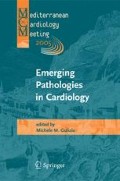Conclusions
It may be said that CRT has a role in improving functional capacity over conventional right ventricular pacing in patients with left ventricular failure who require permanent ventricular stimulation and/or in those with an indication for AV nodal ablation. As for the great majority of patients with advanced heart failure and AF without conventional indications for permanent cardiac pacing — a wide and progressively expanding population in the “border zone” of current indications for CRT — no definite data are available. Some promising results from ablated patients show a favourable trend in major cardiac event reduction after CRT. More controlled clinical data are required to achieve definite conclusions about the indications for CRT in heart failure patients with AF.
Access this chapter
Tax calculation will be finalised at checkout
Purchases are for personal use only
Preview
Unable to display preview. Download preview PDF.
References
Gras D, Mabo P, Tang T et al (1998) Multisite pacing as a supplemental treatment of congestive heart failure: preliminary results of the Medtronic Inc. InSync Study. Pacing Clin Electrophysiol 21:2249–2255
Cazeau S, Leclercq C, Lavergne T et al (2001) Effects of multisite biventricular pacing in patients with heart failure and intraventricular conduction delay. N Engl J Med 344:873–880
Auricchio A, Stellbrink C, Block M et al (1999) Effect of pacing chamber and atrioventricular delay on acute systolic function of paced patients with congestive heart failure. Circulation 99:2993–3001
Abraham WT, Fisher WG, Smith AC et al (2002) Cardiac resynchronization in chronic heart failure. N Engl J Med 346:1845–1853
Bristow MR, Saxon LA, Borhmen J (2004) Cardiac resynchronization therapy with or without an implantable defibrillator in advanced heart failure. N Engl J Med 350:2140–2150
CIBIS II Investigators and Committees (1999) The Cardiac Insufficiency Bisoprolol Study II (CIBIS II): a randomized trial. Lancet 353:9–13
Middelkauf HR, Stevenson WG, Stevenson LW (1991) Prognostic significance of atrial fibrillation in advanced heart failure. A study of 390 patients. Circulation 84:40–48
Stevenson WG, Stevenson LW, Middelkauf HR et al (1996) Improving survival for patients with atrial fibrillation and advanced heart failure. J Am Coll Cardiol 28:1458–1463
Crijns HJGM, Tjeerdsma G, De Kam PJ et al (2000) Prognostic value of the presence and development of atrial fibrillation in patients with advanced chronic heart failure. Eur Heart J 21:1238–1245
Kerwin WF, Botnivick EH, O’Connell JW et al (2000) Ventricular contraction abnormalities in dilated cardiomyopathy: effect of biventricular pacing to correct interventricular dyssynchrony. J Am Coll Cardiol 35:1221–1227
Etienne Y, Mansourati J, Gilard M et al (1999) Evaluation of left ventricular based pacing in patients with congestive heart failure and atrial fibrillation. Am J Cardiol 83:1138–1140
Hay I, Melenovsky V, Barry J et al (2004) Short term effects of right-left sequential cardiac resynchronization in patients with heart failure, chronic atrial fibrillation and atrioventricular nodal block. Circulation 110:3404–3410
Simantirakis EN, Vardakis KE, Kochiadakis GE et al (2004) Left ventricular mechanics during right ventricular apical or left ventricular based pacing in patients with chronic atrial fibrillation after atrioventricular junction ablation. J Am Coll Cardiol 43:1013–1018
Puggioni E, Brignole M, Gammage M et al (2004) Acute comparative effect of right and left ventricular pacing in patients with permanent atrial fibrillation. Circulation 43:234–238
Leon AR, Greenberg JM, Kanuru N (2002) Cardiac resynchronization in patients with congestive heart failure and chronic atrial fibrillation. J Am Coll Cardiol 39:1258–1263
Leclercq C, Victor F, Alonso C et al (2000) Comparative effects of permanent biventricular pacing for refractory heart failure in patients with stable sinus rhythm or chronic atrial fibrillation. Am J Cardiol 85:1154–1156
Leclercq C, Walker S, Linde C et al (2002) Comparative effects of permanent biventricular and right univentricular pacing in heart failure patients with chronic atrial fibrillation. Eur Heart J 23:1780–1787
Linde C, Braunschweig F, Gadler F et al (2003) Long term improvements in quality of life by biventricular pacing in patients with chronic heart failure: results from the Multisite Stimulation In Cardiomyopathy study (MUSTIC). Am J Cardiol 91:1090–1095
Linde C, Leclercq C, Cazeau S et al (2002) Reverse mechanical remodeling by biventricular pacing in congestive heart failure: one-year results from patients in atrial fibrillation in the MUSTIC (Multisite Stimulation In Cardiomyopathy) Study. J Am Coll Cardiol 39:A95–A96
Doshi R for PAVE study group (2004) The Left Ventricular-Based Cardiac Stimulation Post AV Nodal Ablation Evaluation Study. Late breaking clinical trials, ACC 8 March, New Orleans, LA
Kawabata M, Regoli F, Fantoni C et al (2004) Outcome in patients with advanced heart failure and cardiac resynchronization therapy: a comparison between sinus rhythm and atrial fibrillation. Heart Rhythm 1:S59
Gasparini M, Galimberti P, Simonini S et al (2004) Long term results of cardiac resynchronization therapy in patients with permanent atrial fibrillation. Heart Rhythm 1:S59
Nishimura RA, Hayes DL, Holmes DR et al (1995) Mechanism of haemodynamic improvement by dual-chamber pacing for severe left ventricular dysfunction: an acute Doppler and catheterization haemodynamic study. J Am Coll Cardiol 25:281–288
Brignole M, Menozzi C, Gianfranchi L et al (1998) Assessment of atrio-ventricular junction ablation and VVIR pacemaker versus pharmacological treatment in patients with heart failure and chronic atrial fibrillation: a randomized, controlled study. Circulation 98:953–960
Author information
Authors and Affiliations
Editor information
Editors and Affiliations
Rights and permissions
Copyright information
© 2005 Springer-Verlag Italia
About this paper
Cite this paper
Paperini, l., Carluccio, M., Pardini, E. (2005). Is CRT Useful in Patients with Atrial Fibrillation?. In: Gulizia, M.M. (eds) Emerging Pathologies in Cardiology. Springer, Milano . https://doi.org/10.1007/88-470-0341-5_22
Download citation
DOI: https://doi.org/10.1007/88-470-0341-5_22
Publisher Name: Springer, Milano
Print ISBN: 978-88-470-0311-8
Online ISBN: 978-88-470-0341-5
eBook Packages: MedicineMedicine (R0)

